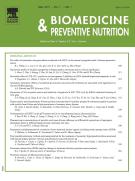Myricetin, a natural flavonoid, normalizes hyperglycemia in streptozotocin-cadmium-induced experimental diabetic nephrotoxic rats - 09/11/12

Abstract |
Myricetin is a flavonoid, it is the major component of traditional medicinal herbs. The present study was designed to evaluate myricetin for its antihyperglycemic and renal protective effect of myricetin on streptozotocin-cadmium-induced diabetic nephrotoxic rats. Diabetic nephrotoxicity were induced by a single intraperitoneal injection of streptozotocin (STZ) (40mg/kg b.w) and cadmium (Cd) as CdCl2 (100p.p.m.) daily in drinking water. STZ-Cd diabetic nephrotoxicity lead to significant (P<0.05) increase in the levels of plasma glucose, glycosylated haemoglobin and significant decrease in the levels of plasma insulin, body weight and total haemoglobin. Diabetic nephrotoxic rats also showed significant increase in the activities of hepatic and renal functional markers (AST, ALT, ALP and urea, creatinine, uric acid, blood urea nitrogen (BUN)) in plasma and significant decrease in the levels of urinary urea, creatinine, uric acid in parallel with increased albumin and urine volume. Intraperitoneal administration of myricetin treated diabetic nephrotoxic rats showed significant protective effects on all the biochemical parameters studied at the end of 30 days treatment. The finding results demonstrate that myricetin at a dose of 1.0mg/kg b.w exhibit more potential antihyperglycemic and renoprotective effect than the other two tested doses (0.5mg and 1.5mg/kg b.w). The outcomes of this preliminary study indicate that myricetin has potential antihyperglycemic agent and protect the kidney from glomerular injury in streptozotocin-cadmium-induced diabetic nephrotoxic rats.
Le texte complet de cet article est disponible en PDF.Keywords : Diabetic nephrotoxicity, Streptozotocin-cadmium, Myricetin
Plan
Vol 2 - N° 4
P. 246-251 - octobre 2012 Retour au numéroBienvenue sur EM-consulte, la référence des professionnels de santé.
L’accès au texte intégral de cet article nécessite un abonnement.
Déjà abonné à cette revue ?

